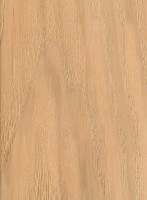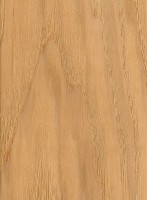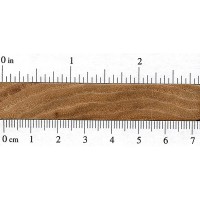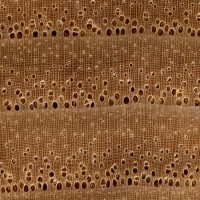 |
Common Name(s): Bitternut Hickory Scientific Name: Carya cordiformis Distribution: Eastern United States Tree Size: 100-130 ft (30-40 m) tall, 2-3 ft (.6-1.0 m) trunk diameter Average Dried Weight: 46 lbs/ft3 (735 kg/m3) Specific Gravity (Basic, 12% MC): .60, .74 Janka Hardness: 1,500 lbf (6,670 N)* *Estimated hardness based on specific gravity Modulus of Rupture: 17,100 lbf/in2 (117.9 MPa) Elastic Modulus: 1,790,000 lbf/in2 (12.35 GPa) Crushing Strength: 9,040 lbf/in2 (62.3 MPa) Shrinkage:Volumetric: 13.6% |
Color/Appearance: Heartwood tends to be light to medium brown, with a reddish hue; sapwood is a paler yellowish brown. Boards with contrasting heartwood and sapwood create a somewhat rustic appearance that’s sometimes marketed as Calico Hickory.
Grain/Texture: Grain is usually straight, though occasionally wavy, with a medium texture. Pores are medium-sized and open.
Rot Resistance: Considered to be non-durable to perishable regarding heartwood decay, and also very susceptible to insect attack.
Workability: Difficult to work, with tearout being common during machining operations if cutting edges are not kept sharp; the wood tends to blunt cutting edges. Glues, stains, and finishes well. Responds well to steam bending.
Odor: No characteristic odor.
Allergies/Toxicity: Besides the standard health risks associated with any type of wood dust, no further health reactions have been associated with Bitternut Hickory. See the articles Wood Allergies and Toxicity and Wood Dust Safety for more information.
Pricing/Availability: Various species of Hickory and Pecan (Carya genus) are typically mixed together and simply sold as Hickory. Prices are usually in the low to mid range, depending upon local availability. Hickory prices should compare similarly to other utility hardwoods such as Red Oak or Soft Maple.
Sustainability: This wood species is not listed in the CITES Appendices or on the IUCN Red List of Threatened Species.
Common Uses: Tool handles, ladder rungs, wheel spokes, flooring, etc.
Comments: Hickory is among the hardest and strongest of woods native to the United States. On average, Hickory is denser, stiffer, and harder than either White Oak or Hard Maple. The wood is commonly used where strength or shock-resistance is important.
Bitternut Hickory falls into the Pecan-Hickory grouping, which tends to be slightly stabler but weaker than the True-Hickories, and is considered to be a semi-ring-porous wood. The strength characteristics of Pecan are somewhat influenced by the spacing of its growth rings. In general, wood from faster-growing trees, with wider spaced growth rings, tends to be harder, heavier, and stronger than wood from slower-growing trees that have rings which are closer together.
In addition to strength and hardness applications, the wood of Carya species also has a very high thermal energy content when burned, and is sometimes used as fuelwood for wood stoves. Additionally, Hickory is also used as charcoal in cooking meat, with the smoke imparting additional flavor to the food.








I cut a hickory “Carya ovalis?” log this week and posted the pictures online. An “expert” started this is oak and not hickory. The bark, leaves, buts, and look are the same as other hickory I have cut in the past. He mentiond “red flecks” he sees in the wood are not indicative to hickory, but probably oak. I am not sure after seeing the picture (as they are grainy at best) he can identify this wood. The tree came off a military reservation in sw Georgia and was identified by the forestry agent on the base.
It doesn’t look like hickory, it does look like oak.